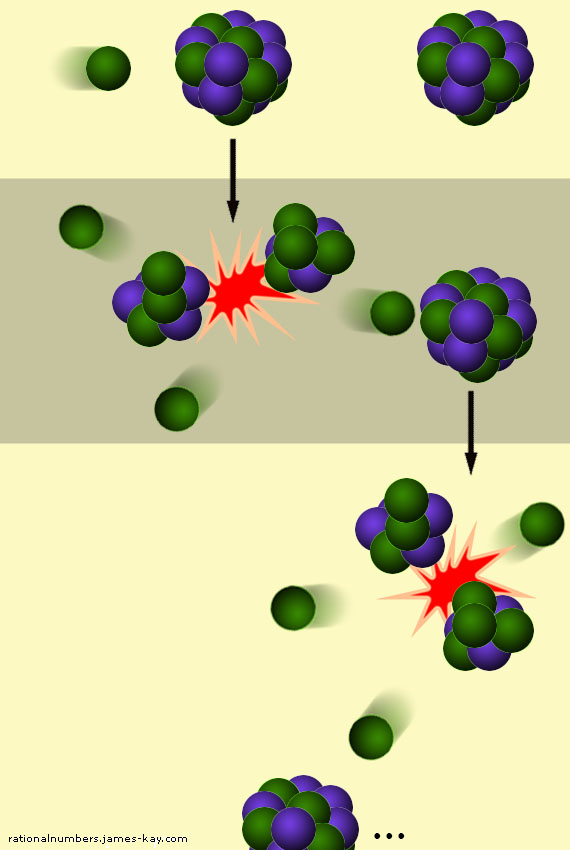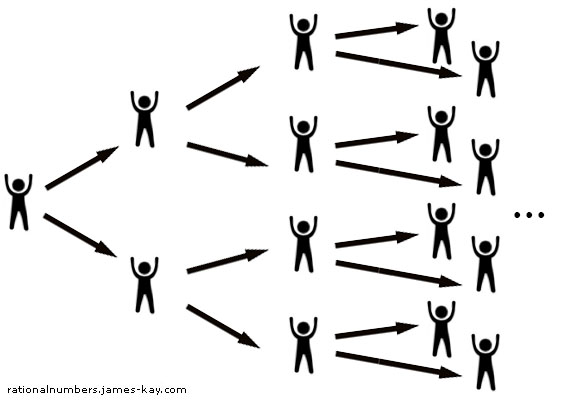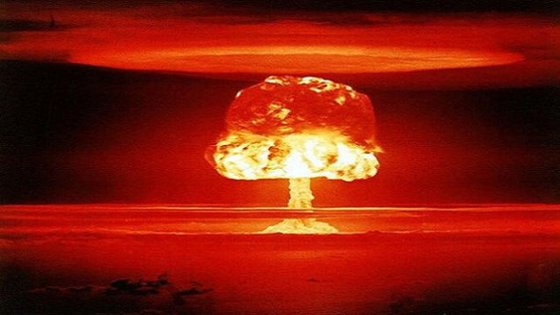A chain reaction is a phenomenon that happens when one event causes similar events to occur.
One example of a chain reaction is the way a Mexican wave (also called a crowd wave, or The Wave) is started and spreads through a crowd at a sporting event. If just a few people start the wave, this can cause other people to do it too, which in turn causes even more people to participate, and it quickly spreads.
The classic example of a chain reaction phenomenon in physics is a nuclear chain reaction. Here, the event is a neutron smashing into an atomic nucleus an causing it to split in half or “fission”. This releases a large amount of energy and also produces more fast-moving neutrons that can fly off and collide with other nearby atoms and cause them to fission also.

The main thing that the outcomes of chain reaction phenomena all critically depend on is the answer to one question: how many additional events does each event cause on average? The outcome of a chain reaction can be dramatically different depending on this number.
Imagine what would happen if you tried to start a Mexican wave in a the wrong place, somewhere like in a library or a retirement home. You probably won’t have much success. Your wave will probably not inspire even one additional person to do the wave also, and in the unlikely event that it does, that person’s wave will not usually lead to any additional participation. The wave won’t get started at all, or it will die out very quickly.
In the case of a nuclear chain reaction this is referred to as a subcritical reaction. In this situation, when the fission of an atom occurs the average number of neutrons that shoot off and cause another atom to fission is less than 1. This important number is called the neutron multiplication factor. As an example, if the neutron multiplication factor was one half, then the neutrons produced from the fission of four atoms will cause the fission of around two additional atoms, and the neutrons from those will cause only cause about one more. Fewer and fewer occur each time and the reaction decreases and dies out.
On the other hand, if you try to start a Mexican wave in an arena full of enthusiastic sports fans you might have better luck. Imagine if each person who does the wave triggers two other people to do it as well. We could say there is a “crowd multiplication factor” of 2. Your wave triggers two other people to participate, and their participation triggers four more, who trigger eight more, and soon enough nearly the entire crowd is involved.

This is analogous to what’s called a supercritical nuclear reaction. When the neutron multiplication factor is greater than 1 then the fission of each atom tends to cause more than one additional fission event and the reaction grows stronger and stronger.
Physics teachers often like to teach students about this process using a demonstration that involves mouse traps with ping-pong balls balanced on them. When one mouse trap is set off it hurls its ping pong ball into the air, just like the neutrons that are produced by the fission of an atom, and these can set off other nearby mousetraps in a chain reaction:
The important thing to understand here is how sensitive the outcome can be to the multiplication factor. Even a very tiny difference in the multiplication factor can make the difference between a chain reaction that dies out and one that grows and grows.
The sharing of articles through social networks is another kind of chain reaction. When a person reads something that a friend has shared on social media, they might like it enough that they choose to share it again. What eventually happens will depend on the average number of people who will re-share the article if it is shared with them – we might call this the social multiplication factor. When an article’s social multiplication factor is less than one it might get shared a few more times, but the chain reaction of sharing will eventually die out. On the other hand, if the social multiplication factor is greater than one, then each sharing tends to lead to more and more sharing and the article’s reach grows and grows. This is the phenomenon known as going viral.
Going viral is what happens when something on the internet has a social multiplication factor greater than one.
Unfortunately, the reasons that determine an idea’s social multiplication factor often have little to do with the truth of the idea. People are more likely to share things on social media because they like the sensational story it tells, or as a visible signal of their political allegiances, than because they considered it and fact-checked it and it seems to truly reflect reality. Wrong ideas are often able to spread as easily as right ideas, but wrong ideas hurt people.
There are those who promote greater skepticism among users of social networks as a way to try to reduce the amount of nonsense and misinformation that gets passed around. A common objection to this strategy is that it won’t make a large enough difference to be worthwhile. “Perhaps“, the objection goes, “we might be able to convince a few percent more people to do some basic fact checking before they share something online, but that would only reduce the spread of misinformation by a small amount.”
This is not the case.
A nuclear reactor producing a steady amount of energy has a neutron multiplication factor of 1, but to shut down a nuclear reactor you don’t have to make the neutron multiplication factor go down to zero. You don’t even have to make it go down to 0.9 or even 0.99. In fact, a typical nuclear reactor will shut down quickly if its neutron multiplication factor is reduced to 0.997.
Tiny changes here can often make a very big difference. The Mexican wave example from before, where each person starting the wave inspired 2 more people, actually isn’t that similar to a nuclear power reactor. A nuclear reaction with a neutron multiplication factor of 2 looks more like this:

Since sharing on social media is a chain reaction phenomenon, it may often be very sensitive to small changes in the social multiplication factor – the number of people who will re-share something that has been shared with them. Even a tiny bit of extra skepticism applied to some bit of nonsense circling the social networks could very well make the difference between going viral and fizzling out.
